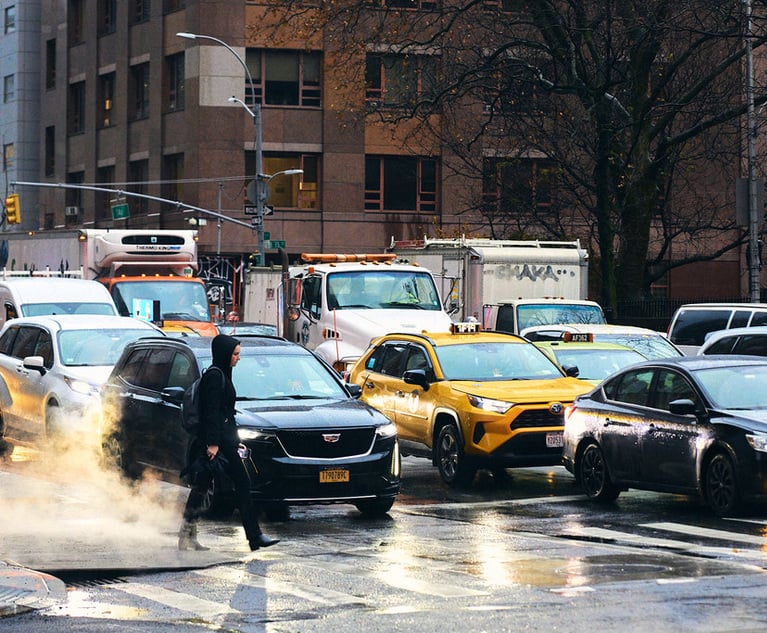Should E-Bikes and E-Scooters Be Regulated in New Jersey?
"The rapid rise of these vehicles has, to date, outpaced the development of a full regulatory regime in New Jersey," writes Nicole Marie Lombardi.
August 01, 2024 at 10:00 AM
9 minute read
 New Jersey's roads are buzzing—literally. Electric bikes and scooters are zipping through neighborhoods, carving a path toward a greener, more convenient future. A favorite among food delivery drivers and short-distance commuters and errand-runners, "e-bikes" and "e-scooters" are changing how New Jersey pedestrians, cyclists and drivers share the road. These "micromobility" vehicles, however, are not without their risks. According to a recent University of California San Francisco study, e-bike injuries across the U.S. increased from 751 in 2017 to 23,493 in 2022, and e-scooter injuries rose from 8,566 to 56,847 over that timeframe.
New Jersey's roads are buzzing—literally. Electric bikes and scooters are zipping through neighborhoods, carving a path toward a greener, more convenient future. A favorite among food delivery drivers and short-distance commuters and errand-runners, "e-bikes" and "e-scooters" are changing how New Jersey pedestrians, cyclists and drivers share the road. These "micromobility" vehicles, however, are not without their risks. According to a recent University of California San Francisco study, e-bike injuries across the U.S. increased from 751 in 2017 to 23,493 in 2022, and e-scooter injuries rose from 8,566 to 56,847 over that timeframe.
The rapid rise of these vehicles has, to date, outpaced the development of a full regulatory regime in New Jersey. But that appears to be changing. Thanks to recently proposed legislation covering e-bikes and e-scooters, along with a recent New Jersey Supreme Court decision regarding personal injury protection (PIP) coverage for e-scooter riders, a fuller regulatory framework is on the horizon.
Current Regulation of E-Bikes and E-Scooters
Today, N.J.S.A. 39:4-14.16 provides the lion's share of regulations concerning "low-speed" e-bikes and e-scooters. Per N.J.S.A. 39:1-1, "low-speed" e-bikes are bicycles with electric motors that do not provide assistance when the bikes reach a speed of 20 miles per hour. "Low-speed" e-scooters are ones with electric motors "capable of propelling the device with or without human propulsion at a maximum speed of less than 19 miles per hour."
NOT FOR REPRINT
© 2025 ALM Global, LLC, All Rights Reserved. Request academic re-use from www.copyright.com. All other uses, submit a request to [email protected]. For more information visit Asset & Logo Licensing.
You Might Like
View All

Tensions Run High at Final Hearing Before Manhattan Congestion Pricing Takes Effect
4 minute read
So Who Won? Congestion Pricing Ruling Leaves Both Sides Claiming Victory, Attorneys Seeking Clarification
4 minute read
Hit by Mail Truck: Man Agrees to $1.85M Settlement for Spinal Injuries
Trending Stories
Who Got The Work
J. Brugh Lower of Gibbons has entered an appearance for industrial equipment supplier Devco Corporation in a pending trademark infringement lawsuit. The suit, accusing the defendant of selling knock-off Graco products, was filed Dec. 18 in New Jersey District Court by Rivkin Radler on behalf of Graco Inc. and Graco Minnesota. The case, assigned to U.S. District Judge Zahid N. Quraishi, is 3:24-cv-11294, Graco Inc. et al v. Devco Corporation.
Who Got The Work
Rebecca Maller-Stein and Kent A. Yalowitz of Arnold & Porter Kaye Scholer have entered their appearances for Hanaco Venture Capital and its executives, Lior Prosor and David Frankel, in a pending securities lawsuit. The action, filed on Dec. 24 in New York Southern District Court by Zell, Aron & Co. on behalf of Goldeneye Advisors, accuses the defendants of negligently and fraudulently managing the plaintiff's $1 million investment. The case, assigned to U.S. District Judge Vernon S. Broderick, is 1:24-cv-09918, Goldeneye Advisors, LLC v. Hanaco Venture Capital, Ltd. et al.
Who Got The Work
Attorneys from A&O Shearman has stepped in as defense counsel for Toronto-Dominion Bank and other defendants in a pending securities class action. The suit, filed Dec. 11 in New York Southern District Court by Bleichmar Fonti & Auld, accuses the defendants of concealing the bank's 'pervasive' deficiencies in regards to its compliance with the Bank Secrecy Act and the quality of its anti-money laundering controls. The case, assigned to U.S. District Judge Arun Subramanian, is 1:24-cv-09445, Gonzalez v. The Toronto-Dominion Bank et al.
Who Got The Work
Crown Castle International, a Pennsylvania company providing shared communications infrastructure, has turned to Luke D. Wolf of Gordon Rees Scully Mansukhani to fend off a pending breach-of-contract lawsuit. The court action, filed Nov. 25 in Michigan Eastern District Court by Hooper Hathaway PC on behalf of The Town Residences LLC, accuses Crown Castle of failing to transfer approximately $30,000 in utility payments from T-Mobile in breach of a roof-top lease and assignment agreement. The case, assigned to U.S. District Judge Susan K. Declercq, is 2:24-cv-13131, The Town Residences LLC v. T-Mobile US, Inc. et al.
Who Got The Work
Wilfred P. Coronato and Daniel M. Schwartz of McCarter & English have stepped in as defense counsel to Electrolux Home Products Inc. in a pending product liability lawsuit. The court action, filed Nov. 26 in New York Eastern District Court by Poulos Lopiccolo PC and Nagel Rice LLP on behalf of David Stern, alleges that the defendant's refrigerators’ drawers and shelving repeatedly break and fall apart within months after purchase. The case, assigned to U.S. District Judge Joan M. Azrack, is 2:24-cv-08204, Stern v. Electrolux Home Products, Inc.
Featured Firms
Law Offices of Gary Martin Hays & Associates, P.C.
(470) 294-1674
Law Offices of Mark E. Salomone
(857) 444-6468
Smith & Hassler
(713) 739-1250






